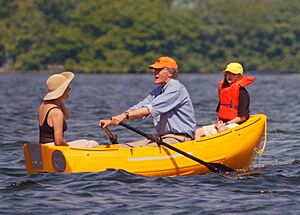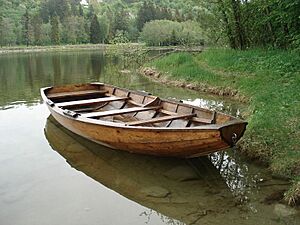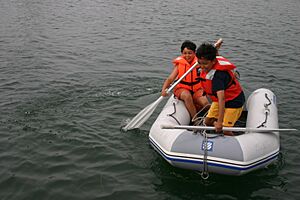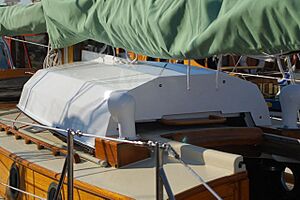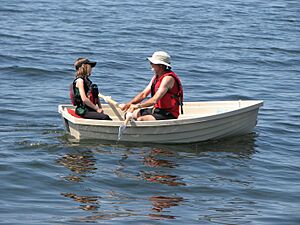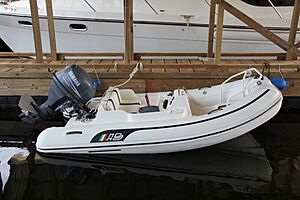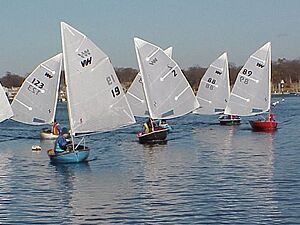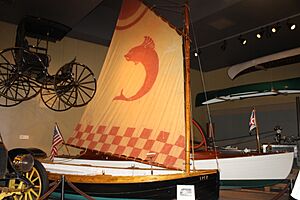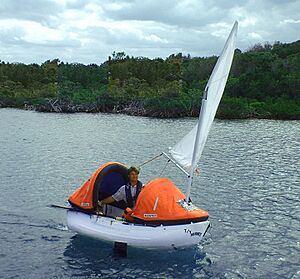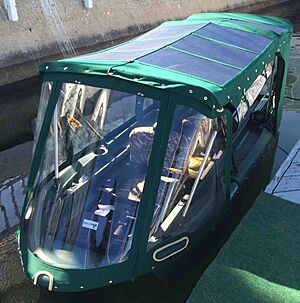Dinghy facts for kids
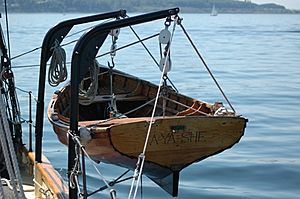
A dinghy is a small boat. People often carry or tow a dinghy behind a larger boat. It acts like a "tender," helping people get to shore from the bigger boat. This is useful when the larger boat cannot easily dock at a port or marina.
Dinghies can be rowboats, have an outboard motor, or even be set up for sailing. Sometimes, the term "dinghy towing" also describes pulling a car behind a motorhome, just like a boat pulls a dinghy.
Contents
Where Does the Name "Dinghy" Come From?
The word "dinghy" comes from languages like Bengali, Urdu, and Hindi. In these languages, words like ḍiṅgi mean "small boat." The British Royal Navy started using this word to describe the smallest boats on their ships.
What Makes a Dinghy Special?
A dinghy is usually a small, open boat. It does not have a roof or a deep, fixed fin (called a keel) underneath. Dinghies can move in different ways: with oars, a sail, or an outboard motor. Some dinghies can even use all three!
Dinghies come in many sizes. They can be as short as about 6 feet (1.8 meters) or as long as 20 feet (6 meters). Many dinghies are used as "tenders" for bigger boats. This means they help people travel between a large boat and the shore. Other dinghies are used for fun activities like sailing or just exploring small waterways. They can be made from strong materials like wood, fiberglass, or even tough plastic. Some dinghies are inflatable, which makes them easy to store.
Different Kinds of Dinghies
Dinghies come in various shapes and designs, each suited for different uses.
Small Boats for Big Adventures
- Prams: These dinghies are usually short and have flat ends at both the front (bow) and back (stern). They are very stable and can carry many people or items for their size. Prams are popular on sailboats because they fit well in small spaces.
- Inflatable Dinghies: These boats can be deflated and folded, making them easy to store. Some inflatable dinghies have a hard floor and a strong back (transom) where you can attach an engine. They are very good at floating and can carry a lot of weight.
- Rigid Safety Dinghies: These are strong, hard-hulled boats designed to be very safe. They can be rowed, motored, towed, or sailed. They are often used as everyday tenders and can even act as lifeboats in emergencies because they are almost impossible to sink.
Finding Space for Your Dinghy
Finding a place for a dinghy on a boat can be tricky, especially on smaller yachts. Many boat owners use a dinghy to avoid paying for expensive dock space. They might carry a small, hard dinghy or an inflatable one that can be deflated.
If a dinghy is too big to carry, it can be towed behind the main boat. When towing, it is important to use a strong rope and make sure the dinghy is covered to prevent it from filling with water. Some dinghies can even be taken apart into smaller pieces for easier storage. For example, a two-piece dinghy might have its front section fit inside the back section.
What Are Dinghies Made Of?
Dinghies need to be strong and durable. Many modern dinghies are made from materials like fiberglass or tough plastics. Inflatable dinghies use special fabrics coated with materials like Hypalon or PVC. Some dinghies are still made from wood, which can be lighter.
Important parts of a dinghy include:
- Rings: A strong ring at the front (bow) is used to tie the boat to a dock or for towing. Other rings at the back (stern) help lift the dinghy onto a larger boat.
- Rowlocks: These are special holders for the oars, allowing you to row the boat. Most dinghies have two rowlocks, one for each oar.
- Hardware: Parts like hinges and fasteners are often made from materials like bronze or stainless steel. These metals resist corrosion (rust) from saltwater.
When not in use, dinghies on yachts are often stored upside down on the deck. This saves space and protects them from weather.
How Do Dinghies Move?
Dinghies can be moved in several ways, depending on their design and what they are used for.
Rowing with Oars
Many dinghies are designed for rowing. Smaller dinghies, usually under 12 feet (3.7 meters), are rowed by one person using a pair of oars. Larger dinghies might have space for two or even three rowers. Inflatable dinghies can be harder to row over long distances, so they often use an engine or are paddled.
Powering with a Motor
Many dinghies use an outboard motor attached to the back. These motors can make a dinghy move much faster than rowing. A dinghy with a powerful motor can even "plane," meaning it lifts partly out of the water and skims across the surface. The fuel tank for the motor is usually stored safely inside the boat. Outboard motors can be tilted up, which helps protect them when the dinghy is in shallow water or pulled onto shore.
Sailing with the Wind
Many dinghies are designed for sailing. They use a mast and a sail to catch the wind. Some common sail types for dinghies include the gunter rig or lug rig. These sails are often chosen because they can be easily folded or stored when not in use.
To help a sailing dinghy move efficiently through the water, especially against the wind, it might have a "daggerboard" or "centreboard." These are fins that extend down into the water from the bottom of the boat. They help the dinghy steer and prevent it from being pushed sideways by the wind.
Solar Power for Dinghies
Some modern dinghies use solar power! They have flexible solar panels, often built into a sunshade (called a bimini top). These panels collect energy from the sun and store it in a lithium battery. This stored energy then powers electric motors, allowing the dinghy to move quietly through the water. Some solar dinghies can also use other power sources, like a propane engine, for extra speed or longer trips.
See also
 In Spanish: Dingui para niños
In Spanish: Dingui para niños
- Boat building
- Dinghy sailing
- Dinghy racing
- 420 (dinghy)
- Laser (dinghy)


